The Taylor JT-1 Monoplane was a British sports plane, sold in a DIY kit, in a post-war low wing design. The prototype flight took place in 1959. It is estimated that in the period 1960-2015, a total of approx. 110 sets of this aircraft were sold. In the basic version, the drive was provided by a single 38 HP JAP engine. The length of the machine was 4.57 meters with a wingspan of 6.4 meters. The maximum speed reached approx. 170 km / h, and the flight range slightly exceeded 350 kilometers. The JT-1 Monoplane was developed by John Taylor. The first sketches of the machine appeared in 1956, and three years later its flight test took place. The constructor wanted to create the cheapest possible aircraft - both in terms of production and operation. He also tried to make the plane as simple as possible to assemble by himself, which he largely succeeded. It is worth noting that the Taylor JT-1 Monoplane has good flight characteristics, and in the hands of a well-trained pilot, it is even capable of performing the most basic aerobatics! The JT-2 (Titch) aircraft was the successor of the JT-1 model.
The Taylor JT-2 Titch is a British sports plane, sold in kits for self-assembly, in a low wing configuration. The prototype flight took place in January 1967. It is estimated that in the period 1967-2011, a total of about 40 sets of this aircraft were sold. Interestingly, it is still on sale! In the basic version, the drive was provided by a single Continental C85-12F engine with 85 HP. The length of the machine was 4.92 meters with a wingspan of 5.72 meters. The maximum speed was around 320 km / h. The JT-2 Titch plane was developed by John Taylor as a specific development of the JT-1 model. The new machine, compared to its predecessor, was characterized by a much more streamlined hull, better aerodynamics, but also had an engine with a clearly greater maximum power. All this contributed to the improvement of performance - especially flight speed and climb. Although in the end the JT-2 turned out to be a successful design, its designer died during its testing in 1967. However, the plane was put on sale thanks to the determination of John Taylor's wife and son.






